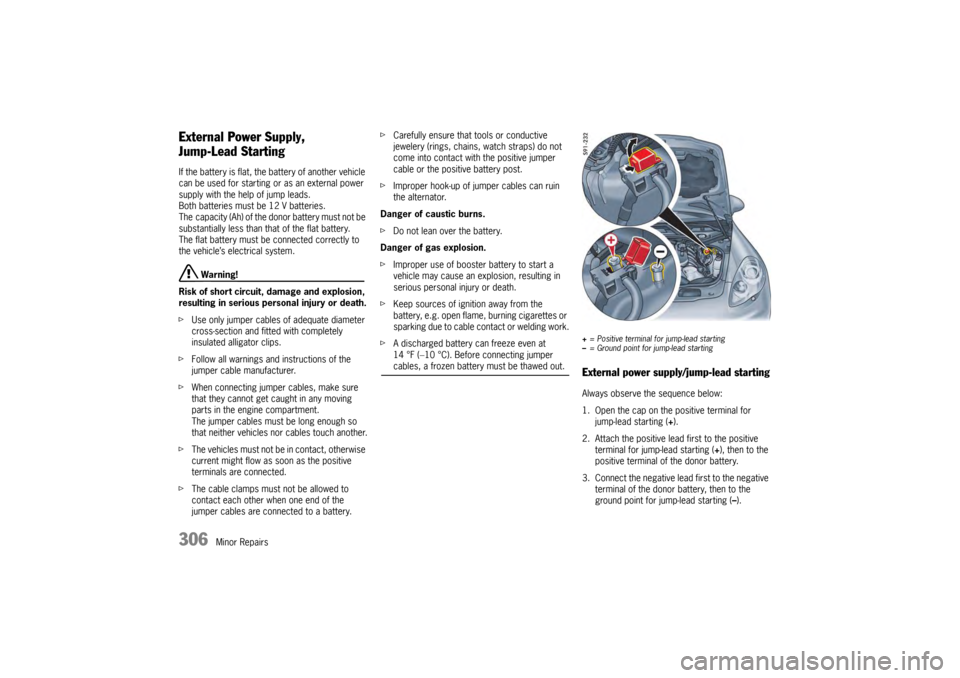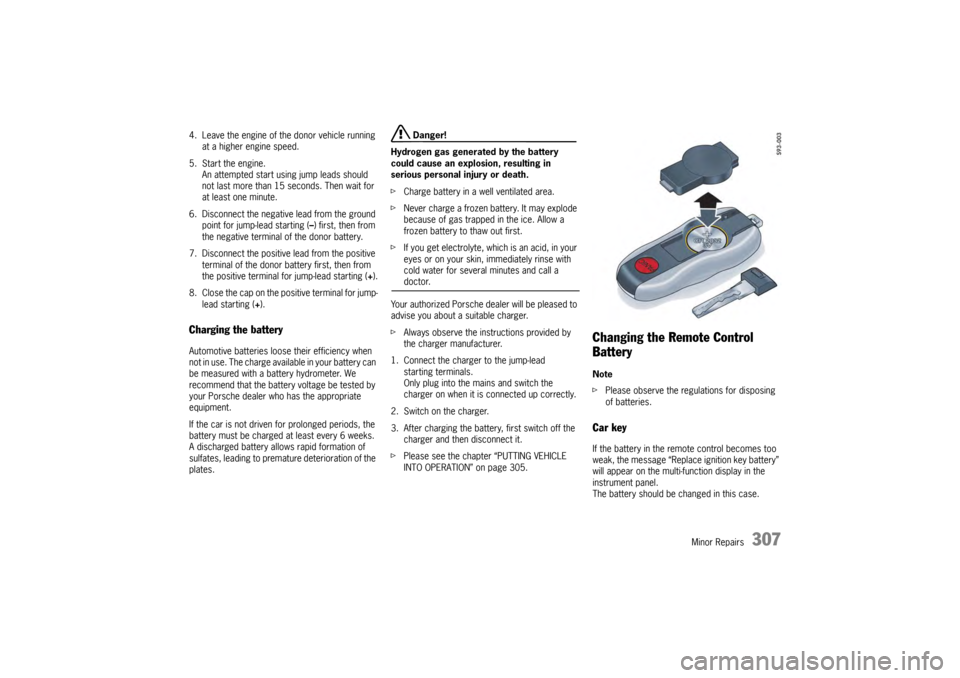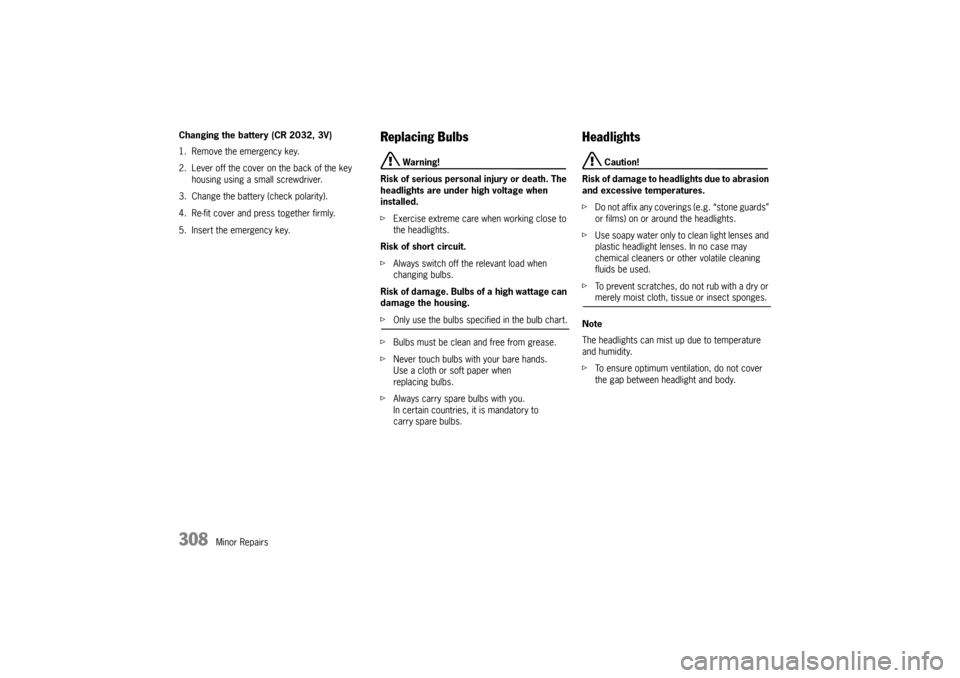PORSCHE PANAMERA 2009 1.G Information Manual
Manufacturer: PORSCHE, Model Year: 2009, Model line: PANAMERA, Model: PORSCHE PANAMERA 2009 1.GPages: 343, PDF Size: 7.96 MB
Page 301 of 343

Minor Repairs
299
Fuse box in left side of dashboardNo.Designation A
1 Steering column switch 7.5
2 Instrument cluster 7.5
3PCM 3.1 10
4 Additional instrument 5
5 Air conditioning, front + rear 10
6 Rearview camera 5
7 LHD, electric parking brake button 5
8 LHD, central locking for rear left
door
RHD, central locking for left doors 10
9 LHD, steering column adjustment 15
10 LHD, PDK control unit 25
11 Power windows, rear left 25
12 Power windows, front left 25
13 ParkAssist 5
14 Xenon headlight, left 15
15 Interior mirror,
LHD, diagnostic socket 5
16 LHD, PDK control unit,
clutch sensor
RHD, air conditioning, sun sensor 5
17 Not used
18 Not used
19 Not used
20 LHD, ignition lock control unit, light
switch 5
21LHD, central locking for front
left door
RHD, mobile phone charger 10
5
22 Steering column lock 5
23 Left-hand drive vehicles only:
Turn signal, rear right
Marker light, front left
Low beam headlight, right
High beam headlight, right
Side turn signals, front
Cornering light, front left
Ignition lock
Two-tone horns
PSM
Starter relay
Emergency flasher switch LED
Ignition lock lighting
Turn signal, front left/right
Footwell lights
Ignition lock anti-removal lock
Power steering control valves 30
No.
Designation A
24Left-hand drive vehicles only:
Turn signal, rear left
Marker light, front right
Low beam headlight, left
High beam headlight, left
Cornering light, front right
Engine compartment lid light
Shutter elements, right/left
Active brake ventilation
open/closed
Heatable washer jets
Engine compartment lid
Headlight beam adjustment 30
25 Left-hand drive vehicles only:
Steering column lock
Filler flap closed/open
Windshield washer pump,
front/rear 15
26 LHD, headlight cleaning system 30
27 Ignition coils 15
28 Not used
29 Oil level sensor, camshaft sensor 7.5
30 Oxygen sensors behind catalytic
converter 7.5
31 Electric control valves for engine 15
32 Engine control unit 20
33 Fan activation,
tank leakage detection 10
34 Valves for engine 10
35 Oxygen sensors ahead of catalytic
converter 10
No.
Designation A
Page 302 of 343

300
Minor Repairs
Fuse box in right side of dashboard
36 Not used
37 Not used
38Front cigarette lighter,
luggage compartment socket 20
39 Seat adjustment, front left
without memory 30
40 RHD, center console sockets,
glove box 20
41 PSM control unit 10
42 Interior light in roof console 7.5
43 Not used
44 Not used
45 Not used
46 Not used
47 Slide/tilt roof 30
48 Windshield wipers 30
49 Engine control unit 5
50 Not used
51 Seat adjustment, front left
with memory 30
52 Seat adjustment, rear left 20
53 Circulating pump 10
54 Rain sensor 5
55 Not used
56 Not used
57 Air-conditioning system fan 40
No.
Designation A
No.Designation A
1 Tire Pressure Monitoring control unit 5
2 Not used
3 Seat heating, front 30
4 Seat heating, rear 30
5 Seat adjustment, rear right 20
6 Not used
7 Not used
8 Seat adjustment, front right
with memory 30
9 RHD, electric parking brake button 5
10 LHD, handset, mobile phone charger
RHD, steering column adjustment 5
15
11 RHD, PDK control unit 25
12 LHD, telephone 5
13 Not used
14 Xenon headlight, right 15
15 Not used
16 RHD, diagnostic socket 5
17 PSM control unit 5
18 LHD, air conditioning, sun sensor
RHD, PDK control unit,
clutch sensor 5
19 Garage door opener 5
20 Air bag control unit 7.5
21 Advanced air bag, occupant sensing 5
22 Steering column switch 5
23 Adaptive cruise control (ACC) 5
24 Seat ventilation, front seats 7.5
25 Seat ventilation, rear seats 7.5
26 Not used
27Front center console socket,
Rear cigarette lighter 20
28 Seat adjustment, front right
without memory 30
29 LHD, rear center console socket,
socket in glove box,
socket in large rear center console 20
30 Not used
31 Coolbox 15
32 Rear Seat Entertainment 7.5
33 Right-hand drive vehicles only:
Turn signal, rear right
Marker light, front left
Low beam headlight, right
High beam headlight, right
Side turn signals, front
Cornering light, front left
Ignition lock
Two-tone horns
PSM
Starter relay
Emergency flasher switch LED
Ignition lock lighting
Turn signal, front left/right
Footwell lights
Ignition lock anti-removal lock
Power steering control valves 30
No.
Designation A
Page 303 of 343

Minor Repairs
301
Fuse and relay carriers
in the luggage compartment
34Right-hand drive vehicles only:
Turn signal, rear left
Marker light, front right
Low beam headlight, left
High beam headlight, left
Cornering light, front right
Engine compartment lid light
Shutter elements, right/left
Active brake ventilation
open/closed
Heatable washer jets
Engine compartment lid
Headlight beam adjustment 30
35 Right-hand drive vehicles only:
Steering column lock
Filler flap closed/open
Windshield washer pump,
front/rear 15
36 RHD, headlight cleaning system 30
37 Not used
38 Not used
39 PSM control unit 25
40 LHD, central locking for front/rear
right door 10
41 Power windows, front right 25
42 Power windows, rear right 25
43 Alarm horn 5
44 Vehicle Tracking System VTS 5
45 Not used
46 Not used
No.
Designation A
47 Fuel pump control unit 25
48 Horn (two-tone horns) 15
49 Diagnostic socket 5
50 RHD, ignition lock, light switch 5
51 RHD, central locking for front right
door 10
52 RHD, steering column lock 5
53 Not used
54 Not used
55 Not used
56 Not used
57 PSM pump control unit 40
No.
Designation A
No. Fuse carrier A A
1Not used
2 Spoiler flap (Turbo) 10
3 Audio amplifier (Burmester
®)
Audio amplifier (ASK Sound, Bose) 30
25
4 Start/Stop control unit 30
5 Start/Stop control unit 30
6 Differential lock 10
7 Differential lock 30
8 Subwoofer (Bose, Burmester®)30
9 Powerlift tailgate 25
10 PASM control unit 25
11 Luggage compartment lights 5
12 PDCC control unit 10
Page 304 of 343

302
Minor RepairsLHD = Left-hand drive vehicles
RHD = Right-hand drive vehicles
Note
f
Use the plastic gripper D when replacing the
fuses. This can be found in the fuse box cover
on the dashboard.
f Spare fuses can be found in both fuse box
covers on the dashboard (left: 7.5 and 10 A;
right: 20 and 25 A).
No. Fuse carrier B
A
1 Daytime driving lights, right
Tail light, right
Reversing light, right
Rear fog light, left
Brake light, right
Raised brake light
Sun blind
Electric steering column lock
Rear wiper
Heated rear window
Interior surveillance/inclination
sensor
PA S M
Engine control unit
Safety/curb lights, front doors
Interior light/reading light, front
Interior light, rear
Orientation light
Licence plate light
Engine speed hall senders 1+3
Interior light 15
2 Daytime driving lights, left
Tail light, left
Reversing light, left
Rear fog light, right
Brake light, left
Safety/curb lights, rear doors
Exhaust flap control
Filler flap closed
Extend/retract spoiler 15
3
Tailgate closing mechanism
Filler flap open
Retract/extend rear spoiler
Sun blind 30
4 Alarm horn 15
5 Gateway control unit 5
6 Heated rear window 20
7 PASM control unit 5
8 Gateway control unit 5
9 Electric parking brake 5
10 Differential lock 10
11 PDCC control unit 10
12 Rear wiper 15
No. Fuse carrier B
A
No.Relay carrier C
1 Heated rear window
2 Not used
3 Spoiler flap (Turbo)
4 Spoiler flap (Turbo)
5 PASM/LF compressor
Page 305 of 343

Minor Repairs
303
Battery
Danger!
Risk of short circuit and fire, resulting in
serious personal injury or death.
f Observe all warning notes on the battery.
f Disconnect the negative terminal on the
battery during all work on the electrical
system.
f Do not lay tools or other metal objects on the
battery as they could cause a short circuit
across the battery terminal.
Hydrogen gas generated by the battery
could cause an explosion, resulting in
serious personal injury or death.
f Charge battery in a well vetilated area.
f Never charge a frozen battery. It may explode
because of gas trapped in the ice. Allow a
frozen battery to thaw out first.
f Do not expose the battery to an open flame,
electrical spark or a lit cigarette.
Risk of explosion as a result of static charge,
resulting in serious personal injury or death.
f Do not wipe the battery with a dry cloth.
f Before touching the battery, discharge any
static electricity by touching the vehicle. Risk of serious personal
injury or death and
damage to the fabric, metal or paint.
f Wear eye protection.
f Do not allow battery acid to come in contact
with your skin, eyes, fabric or painted
surfaces.
f If you get electrolyte, which is an acid, in your
eyes or on your skin, immediately rinse with
cold water for several minutes and call a
doctor.
f Spilled electrolyte must be rinsed off at once
with a solution of baki ng soda and water to
neutralize the acid.
Battery posts, terminals and related
accessories contain lead and lead
compounds, chemicals known to the State of
California to cause cancer and reproductive
harm.
f Always protect your skin by washing
thoroughly with soap and water.
The battery is located in the battery box under the
left front seat.
Charge stateA well charged battery will not only prevent
starting problems but will also last longer.
In order to avoid unintended battery
discharge
f Switch off unnecessary electrical loads in city
traffic, on short trips or in a line of traffic.
f Always remove the ignition key from the
ignition switch when leaving the vehicle or
switch ignition off in vehicles with Porsche
Entry & Drive.
f Avoid using the Porsche Communication
Management system and the audio system
when the engine is not running.
Maintenance note
In the cold season, in part icular, or if you mainly
drive only short distances, it may become
necessary to recharge the battery from time to
time.
Page 306 of 343

304
Minor Repairs
Battery carefEnsure that battery is securely mounted.
f Keep terminals and connections clean and
properly tightened. Corrosion can be
prevented by coating the terminals and
connections with petroleum jelly or silicone
spray.
f Ensure that vent caps ar e securely tightened to
prevent spillage.
Checking the electrolyte fluid level
(only on low-maintenance batteries)
Generally, the electrolyte level must be checked
more often in summer than in the winter, and more
often when driving long distances.
f When adding water, use only clean containers.
In no case may alcohol (e.g. window cleaner
residues) be permitted to enter the battery.
f Unscrew and open the filler vent caps of each
cell.
With the car on a level surface, the fluid level
should meet the indicator mark in each cell.
f If necessary, top up with distilled water. Do not
use acid. Only fill up to the mark, otherwise the
electrolyte will overflow when the battery is
being charged and cause damage.
Winter operationDuring the winter months, battery capacity tends
to decrease as temperatures drop. Additionally,
more power is consumed while starting, and the
headlights, heater, rear window defogger, etc.,
are used more frequently.
f Let your Porsche dealer test the battery's
capacity before winter sets in.Vehicle storageIf the car stands for long periods in the garage or
workshop, the doors and lids should be closed.
f Remove the ignition key and, if necessary,
disconnect the battery.
Notes on operation
f When the battery is disconnected, the alarm
system ceases to function.
If the vehicle was locked before the battery
was disconnected, the alarm will be triggered
when the battery is reconnected.
To deactivate the alarm system:
f Lock the vehicle and unlock it again.
Alarm system, central locking
f The status of the central locking and alarm
system is not changed by disconnecting the
battery. Maintenance notes
Even if you put your vehicle out of operation, the
battery still discharges.
The battery will discharge more quickly if your
vehicle is not driven on a daily basis over a
distance of several miles. The more often you
drive your vehicle, and
the longer the distance
driven on each trip, the more opportunity the
vehicle‘s charging system w ill have to recharge the
batteries.
f To preserve its efficiency, charge the battery
about every 6 weeks.
f Check the battery acid level and top off with
distilled water if necessary.
f Store a battery that has been removed in a
dark, cool place, but not subject to freezing.
Page 307 of 343

Minor Repairs
305
Replacing the batteryThe service life of the battery is subject to normal
wear; it depends greatly on care, climatic
conditions, and driving conditions (distances,
loads).
f Only use an original Porsche battery, with the
correct part number, as a replacement. Only
this battery meets the spec ific requirements of
the vehicle.
f Please observe the disposal instructions for
batteries.
Putting vehicle into operationAfter the battery is connected or after a fully
discharged battery is charged, the PSM warning
light lights up on the instrument panel and
a message appears on the multi-function display
in the instrument panel to indicate a fault.
This fault can be corrected with a few
simple steps:
1. Start the engine. To do this, turn the igni tion key or the control
unit (on vehicles with Porsche Entry & Drive)
to ignition lock position 2, twice .
2. With the vehicle stationary, perform a few steering movements to the left and right and
then drive a short distance in a straight line
until the PSM warning light goes out and the
message is erased from the multi-function
display in the instrument panel.
3. If the warnings do not disappear, then:
Drive carefully to the nearest authorized
Porsche dealer to have the fault corrected.
4. After the warnings go out: Stop the vehicle in a suitable place.
5. Store the end position for the power windows. For information on storin
g the end positions for
the power windows:
f Please see the chapter “STORING END
POSITION OF THE DOOR WINDOWS AFTER
CONNECTING THE VEHICLE BATTERY” on
page 88.
6. Teach tires on vehicles with Tire Pressure Monitoring.
For information on teaching the Tire Pressure
Monitoring system:
f Please see the chapter “TIRE PRESSURE
MONITORING (TPM)” on page 127.
7. Store end position on vehicles with a slide/ tilt roof.
For information on storing the end position for the
slide/tilt roof:
f Please see the chapter “STORING END
POSITION OF THE SLIDE/TILT ROOF” on
page 90.
Page 308 of 343

306
Minor Repairs
External Power Supply,
Jump-Lead StartingIf the battery is flat, the battery of another vehicle
can be used for starting or as an external power
supply with the help of jump leads.
Both batteries must be 12 V batteries.
The capacity (Ah) of the do nor battery must not be
substantially less than that of the flat battery.
The flat battery must be connected correctly to
the vehicle’s electrical system.
Warning!
Risk of short circuit, damage and explosion,
resulting in serious personal injury or death.
f Use only jumper cables of adequate diameter
cross-section and fitted with completely
insulated alligator clips.
f Follow all warnings and instructions of the
jumper cable manufacturer.
f When connecting jumper cables, make sure
that they cannot get ca ught in any moving
parts in the engine compartment.
The jumper cables must be long enough so
that neither vehicles nor cables touch another.
f The vehicles must not be in contact, otherwise
current might flow as soon as the positive
terminals are connected.
f The cable clamps must not be allowed to
contact each other when one end of the
jumper cables are connected to a battery. f
Carefully ensure that tools or conductive
jewelery (rings, chains, watch straps) do not
come into contact with the positive jumper
cable or the positive battery post.
f Improper hook-up of jumper cables can ruin
the alternator.
Danger of caustic burns.
f Do not lean over the battery.
Danger of gas explosion.
f Improper use of booster battery to start a
vehicle may cause an explosion, resulting in
serious personal injury or death.
f Keep sources of ignition away from the
battery, e.g. open flame, burning cigarettes or
sparking due to cable contact or welding work.
f A discharged battery can freeze even at
14 °F ( −10 °C). Before connecting jumper
cables, a frozen battery must be thawed out.
+ = Positive terminal for jump-lead starting
– = Ground point for jump-lead startingExternal power supply/jump-lead startingAlways observe the sequence below:
1. Open the cap on the positive terminal for
jump-lead starting ( +).
2. Attach the positive lead first to the positive terminal for jump-lead starting ( +), then to the
positive terminal of the donor battery.
3. Connect the negative lead first to the negative
terminal of the donor battery, then to the
ground point for jump-lead starting ( –).
Page 309 of 343

Minor Repairs
307
4. Leave the engine of the donor vehicle running at a higher engine speed.
5. Start the engine. An attempted start using jump leads should
not last more than 15 seconds. Then wait for
at least one minute.
6. Disconnect the negative lead from the ground
point for jump-lead starting ( –) first, then from
the negative terminal of the donor battery.
7. Disconnect the positive lead from the positive terminal of the donor ba ttery first, then from
the positive terminal for jump-lead starting ( +).
8. Close the cap on the posi tive terminal for jump-
lead starting ( +).Charging the batteryAutomotive batteries loose their efficiency when
not in use. The charge available in your battery can
be measured with a battery hydrometer. We
recommend that the battery voltage be tested by
your Porsche dealer who has the appropriate
equipment.
If the car is not driven for prolonged periods, the
battery must be charged at least every 6 weeks.
A discharged battery allo ws rapid formation of
sulfates, leading to premature deterioration of the
plates.
Danger!
Hydrogen gas genera ted by the battery
could cause an explosion, resulting in
serious personal injury or death.
f Charge battery in a well ventilated area.
f Never charge a frozen battery. It may explode
because of gas trapped in the ice. Allow a
frozen battery to thaw out first.
f If you get electrolyte, which is an acid, in your
eyes or on your skin, immediately rinse with
cold water for several minutes and call a doctor.
Your authorized Porsche dealer will be pleased to
advise you about a suitable charger.
f Always observe the instructions provided by
the charger manufacturer.
1. Connect the charger to the jump-lead starting terminals.
Only plug into the mains and switch the
charger on when it is connected up correctly.
2. Switch on the charger.
3. After charging the battery, first switch off the charger and then disconnect it.
f Please see the chapter “PUTTING VEHICLE
INTO OPERATION” on page 305.
Changing the Remote Control
BatteryNote
f Please observe the regulations for disposing
of batteries.Car keyIf the battery in the remote control becomes too
weak, the message “Replace ignition key battery”
will appear on the multi-function display in the
instrument panel.
The battery should be changed in this case.
Page 310 of 343

308
Minor Repairs
Changing the battery (CR 2032, 3V)
1. Remove the emergency key.
2. Lever off the cover on the back of the key
housing using a small screwdriver.
3. Change the battery (check polarity).
4. Re-fit cover and press together firmly.
5. Insert the emergency key.
Replacing Bulbs
Warning!
Risk of serious personal injury or death. The
headlights are under high voltage when
installed.
f Exercise extreme care when working close to
the headlights.
Risk of short circuit.
f Always switch off the relevant load when
changing bulbs.
Risk of damage. Bulbs of a high wattage can
damage the housing.
f Only use the bulbs specified in the bulb chart.
f Bulbs must be clean and free from grease.
f Never touch bulbs with your bare hands.
Use a cloth or soft paper when
replacing bulbs.
f Always carry spare bulbs with you.
In certain countries, it is mandatory to
carry spare bulbs.
Headlights
Caution!
Risk of damage to headlights due to abrasion
and excessive temperatures.
f Do not affix any coverings (e.g. “stone guards”
or films) on or around the headlights.
f Use soapy water only to clean light lenses and
plastic headlight lenses. In no case may
chemical cleaners or other volatile cleaning
fluids be used.
f To prevent scratches, do not rub with a dry or merely moist cloth, tissue or insect sponges.
Note
The headlights can mist up due to temperature
and humidity.
f To ensure optimum ventilation, do not cover
the gap between headlight and body.